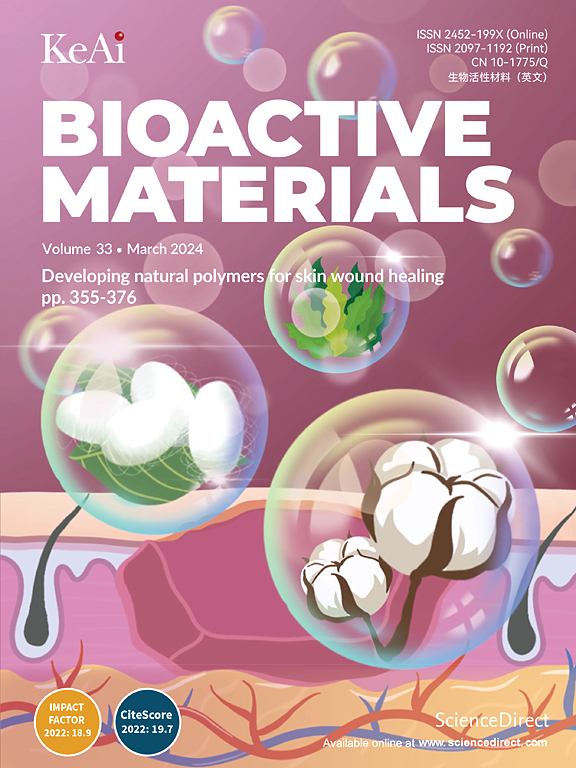Elytra-inspired zirconium phosphate nanonetwork: Toward high-quality osseointegration and physical-chemical-mechanical bond at the interface for zirconia-based dental materials
IF 18
1区 医学
Q1 ENGINEERING, BIOMEDICAL
引用次数: 0
Abstract
Yttria-stabilized zirconia (YSZ) is widely used in dental implants and prostheses due to its excellent aesthetic and restorative properties. However, its bio-inert surface limits early osseointegration and weakens bonding strengths with porcelain veneer/resin cement. Inspired by the structure of beetle elytra, this work proposes a novel strategy involving a self-assembled trabecular-honeycomb biomimetic zirconium phosphate (ZrP) nanonetwork to modify YSZ surfaces. This approach simultaneously enhances energy dissipation, interfacial bonding, and osseointegration. The pore size of ZrP nanonetwork was precisely controlled by adjusting reaction temperatures (120 °C and 160 °C) and phosphoric acid concentrations (1.0 wt% and 2.5 wt%). Compared to conventional YSZ, the ZrP nanonetworks achieved remarkable improvements in bond strength, showing increases of 111 % with porcelain veneer and 336 % with resin cement. These enhancements are attributed to multiscale physical-chemical-mechanical interactions, including micromechanical anchoring, chemical bonding via phosphate groups, and energy dissipation through topological optimization. In vitro studies demonstrated that large-pore-size nanonetworks promote osteogenic differentiation of osteoblasts and modulate macrophage polarization toward the M2 phenotype, fostering an immune environment conducive to bone regeneration. In vivo experiments further validated the superior osseointegration and bone regeneration capacities of the large-pore-size ZrP nanonetwork. Collectively, this biomimetic ZrP nanonetwork-modified YSZ, with its exceptional physical-chemical-mechanical bonding properties, osseointegration potential, and immune-modulating capabilities, represents a groundbreaking advancement in zirconia-based material for dental implants and prostheses.

鞘翅激发的磷酸锆纳米网络:在氧化锆基牙科材料的界面上实现高质量的骨整合和物理-化学-机械结合
钇稳定氧化锆(YSZ)因其优异的美观性和修复性而被广泛应用于种植体和修复体中。然而,其生物惰性表面限制了早期骨整合,削弱了与瓷贴面/树脂水泥的结合强度。受甲虫鞘翅结构的启发,本研究提出了一种新颖的策略,涉及自组装的蜂窝小梁仿生磷酸锆(ZrP)纳米网络来修饰YSZ表面。这种方法同时增强了能量耗散、界面结合和骨整合。通过调节反应温度(120°C和160°C)和磷酸浓度(1.0 wt%和2.5 wt%)来精确控制ZrP纳米网络的孔径。与传统的YSZ相比,ZrP纳米网络的结合强度显著提高,与瓷贴面的结合强度提高了111%,与树脂水泥的结合强度提高了336%。这些增强归因于多尺度物理-化学-机械相互作用,包括微机械锚定,通过磷酸基团的化学键和通过拓扑优化的能量耗散。体外研究表明,大孔径纳米网络促进成骨细胞的成骨分化,调节巨噬细胞向M2表型极化,培养有利于骨再生的免疫环境。体内实验进一步验证了大孔径ZrP纳米网络优越的骨整合和骨再生能力。总的来说,这种仿生ZrP纳米网络修饰的YSZ,具有卓越的物理-化学-机械键合性能,骨整合潜力和免疫调节能力,代表了氧化锆基牙科种植体和修复材料的突破性进展。
本文章由计算机程序翻译,如有差异,请以英文原文为准。
求助全文
约1分钟内获得全文
求助全文
来源期刊

Bioactive Materials
Biochemistry, Genetics and Molecular Biology-Biotechnology
CiteScore
28.00
自引率
6.30%
发文量
436
审稿时长
20 days
期刊介绍:
Bioactive Materials is a peer-reviewed research publication that focuses on advancements in bioactive materials. The journal accepts research papers, reviews, and rapid communications in the field of next-generation biomaterials that interact with cells, tissues, and organs in various living organisms.
The primary goal of Bioactive Materials is to promote the science and engineering of biomaterials that exhibit adaptiveness to the biological environment. These materials are specifically designed to stimulate or direct appropriate cell and tissue responses or regulate interactions with microorganisms.
The journal covers a wide range of bioactive materials, including those that are engineered or designed in terms of their physical form (e.g. particulate, fiber), topology (e.g. porosity, surface roughness), or dimensions (ranging from macro to nano-scales). Contributions are sought from the following categories of bioactive materials:
Bioactive metals and alloys
Bioactive inorganics: ceramics, glasses, and carbon-based materials
Bioactive polymers and gels
Bioactive materials derived from natural sources
Bioactive composites
These materials find applications in human and veterinary medicine, such as implants, tissue engineering scaffolds, cell/drug/gene carriers, as well as imaging and sensing devices.
 求助内容:
求助内容: 应助结果提醒方式:
应助结果提醒方式:


